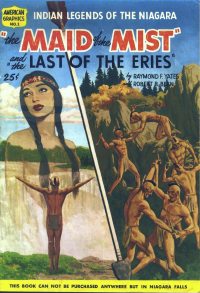| Comments |
| |
| Gracias por vuestro gran trabajo. |
|
| This is superb.
Is Robert Bean, the Artist, this guy?
https://www.lambiek.net/artists/b/bean_bob.htm
Better known as Bob Bean?
Can't find much on him. |
|
| | |
| Additional Information |
| |
| FOUR BLOODY ERAS |
| |
| Before the White Man Came |
| |
| Possibly 7000-8000 years ago. Asiatic nomads crossed the Bering Straits and trickled into North America. This is the most accepted theory of the origin of the American Indians who were essentially a Stone Age people. Tribes eventually known as Hurons, Senecas, Oneidas, Mohawks, Onondagas and Cayugas settled in Canada and what is now New York State. These were forest Indians as compared with the Western or plains Indians. Never a prolific people, inter-tribal warfare threatened to wipe them out. Thus was the Iroquois Confederacy born some four to five hundred years ago and which theoretically, at least, is still in existence among the surviving tribes. The Hurons, failing to join the peace pact, were killed off during the 1640's. During 1712, a hundred-year migration of the Tuscororas began from the Carolinas to New York State. What had been known as the Five Nations became the Six Nations. |
| |
| The French Dream of Empire |
| |
| Samuel de Champlain was among the first of the Frenchmen to see the opportunity of a vast mid-continental North American empire or New France for his country. He established Quebec and first entered New York State in 1609 in the vicinity of the lake still bearing his name. The Recollets, Jesuits, La Salle and many others followed until the whole of Canada and the central part of what is now the U.S.A. was under French control. The main routes to this new-born empire were through the Ottawa River to Lake Huron and the St. Lawrence River to Lake Ontario and the Niagara River to Lake Erie. In 1627, Cardinal Richelieu, then political master of France, limited privilege to Catholic Frenchmen and thereby in a large measure stunted the growth of the French dream. In the meantime England was consolidating her position on the Atlantic Seaboard at the expense of the Dutch and Swedes. Come 1726, the French established Fort Niagara on the Niagara River, the strongest citadel south of Quebec. |
| |
| The English Liquidate a Dream |
| |
| Never wholly devoted to the French cause, the powerful Iroquois, once called the Bronze Romans, were finally won over to the British side largely through the efforts of Sir William Johnson, the thcn young Irishman who resided in the Mohawk Valley of New York and who was appointed by the British Crown as Commissioner of Indian Affairs for North America. Came the time when the French plum was ready for plucking from a badly nourished tree. During the brief (1755-1759) French and Indian War, Braddock moved on Fort Duquesne (Pitts-burgh, Pa.), Sir William Johnson with his Iroquois and regulars crushed Baron Dieskau at Lake George, Prideaux reduced Fort Niagara and the gallant Wolfe won over the Marquis Montcalm on the Plains of Abraham at Quebec. The bold and bloody game of empire had been lost by France. British authority was quickly established at Fort Duquesne, (named Fort Pitt in honor of the English statesman), Fort Detroit, Fort Niagara, and the minor outposts of the French. Barring precarious toeholds of Spain in California and Florida and the French in Louisiana, the English had won a continent. |
| |
| A New Flag Waves Over Niagara |
| |
| At the close of the French and Indian War, Sir William Johnson became lord and master over the territory that had recently been sub-ject to French rule. Pontiac's Rebellion, the last bid of a conquered people, was quickly liquidated and the IroqUois were a captive people. Sensing the approach of revolution, Sir William called an Indian Council at his home in the Mohawk Valley in 1774. He died of a cerebral hemorrhage while addressing it and his inept nephew, Sir Guy Johnson, was appointed his successor. At the outbreak of the American Revolution, Fort Niagara in the Niagara River virtually became the headquarters for British authority. American colonists still loyal to the king flocked into Canada and at the close of the War (1783) the British refused to relinquish their hold on Niagara or the mid-west territory over which it stood guard. For 13 years or until 1796 (called the Holdover Period) they held firm on the pretext of an equitable settlement of the claims of the Loyalists. Finally at the signing of the Jay Treaty (1796) between Great Britain and the United States, the Stars and Strips slithered to the top of the mast at old Fort Niagara the third and last flag to be unfurled there. |
| The data in the additional content section is courtesy of Galactic Central. |




